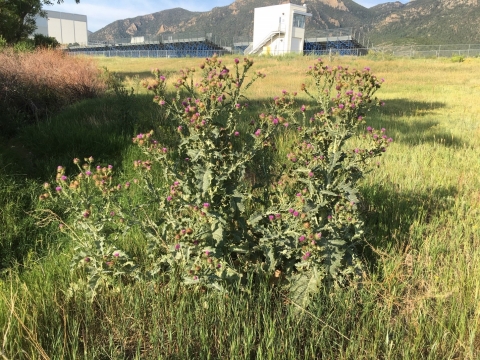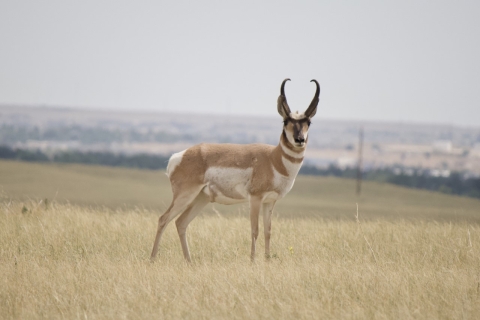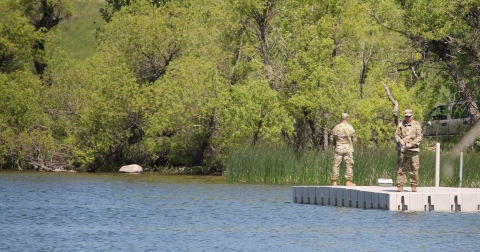What We Do
Our vision is to achieve sustainable native species and ecosystems through leadership, partnerships, and innovation. We work to conserve and restore federal and state threatened trust species and their habitats in the Mountain Prairie region. Under authority of the Sike’s Act, our staff manages natural resources on Department of Defense lands providing effective environmental stewardship with mission objectives to ensure military readiness while protecting natural resources for generations to come. Our recovery efforts include species protection, stream restoration, invasive species invasive species
An invasive species is any plant or animal that has spread or been introduced into a new area where they are, or could, cause harm to the environment, economy, or human, animal, or plant health. Their unwelcome presence can destroy ecosystems and cost millions of dollars.
Learn more about invasive species control, fisheries and wildlife surveys, identification of cultural resources and implementing actions such as controlled burns to achieve healthy forests.
Management and Conservation
Restoring and maintaining wildlife diversity for threatened and endangered species is a primary focus for the Colorado Fish and Wildlife Conservation Office. Projects such as prescribed burns, channel stabilization, riparian riparian
Definition of riparian habitat or riparian areas.
Learn more about riparian and shortgrass prairie habitat restoration, dam removals, and implementing fish and wildlife surveys all contribute to the recovery and conservation efforts within the Fish and Wildlife Service.
National Fish Passage Program
Fish passage is the ability of fish or other aquatic species to move freely throughout their life to find food, reproduce, and complete their natural migration cycles. Millions of barriers to fish passage across the country are fragmenting habitat and leading to species declines. The U.S. Fish and Wildlife Service's National Fish Passage Program is working to reconnect watersheds to benefit both wildlife and people.
Learn more about fish passage for Rio Grande Suckers and Rio Grande Chubs at the Baca National Wildlife Refuge. | Image Details
The National Fish Passage Program is a voluntary, non-regulatory effort that provides assistance in removing or bypassing barriers that impede fish movement in order to restore fish populations. Our office is conserving aquatic ecosystems by maintaining and restoring connectivity through fish passage projects. We work with partners and National Fish Passage Program to increase river connectivity, improve water quality, and improve sediment management. Restoring connectivity reduces habitat fragmentation and increases fish movement, and can ultimately improve sport fishing opportunities as well as conserve endangered and native species.
The Colorado Fish and Wildlife Conservation Office has been involved with several projects to reestablish healthy fish populations through fish passage including:
- Removal of culverts in Thompson Creek near Carbondale, CO
- Habitat improvement in Fountain Creek in Colorado Springs, CO
- Restoration of Tabequache Creek in the San Miguel River drainage in Colorado
- Replacing culverts that prevent fish passage at the Baca National Wildlife Refuge in Colorado to benefit state endangered Rio Grande Sucker and Rio Grande Chub
Forestry and Fire
A prescribed burn is the controlled use of fire to restore wildlife habitat, reduce wildfire risk, or achieve other habitat management goals. We have been using prescribed burn techniques to improve species habitat since the 1930s.
Learn more about prescribed burn at the Rocky Mountain Arsenal National Wildlife Refuge. | Image Details
The Colorado Fish and Wildlife Conservation Office forestry and fuels management strategies include forest overstory thinning, prescribed burning, fuels reduction and mastication, and reforestation. The overstory thinning reduces the number of trees in a stand to space out trees into clusters that vary in size and age with open area in between. This returns forest conditions to a more natural state that improves forest health, reduces the risk of a crown driven wildfire, and reduces of bark beetle and pest attacks while preparing the area for prescribed fire. Prescribed burning is a tool utilized to enhance habitat, train first responders, and reduce fuels. Colorado’s front range is a fire dependent landscape that historically saw frequent (every 7-12 years) low intensity fires usually sparked by lightning. Managing forests with prescribed fire promotes a more resilient forested landscape through a natural process. Reforestation efforts at the US Air Force Academy focus on planting ponderosa pine in recreation areas like trails and fishing lakes and replacing dead “urban” trees with more fire appropriate species that are bee friendly, fast growing, and salt and drought tolerant.
The Wildland Support Module, sponsored by the US Air Force Wildland Fire Center and based out of the Cheyenne Mountain Air Force Station plays a vital role in forestry and fuels management strategies. The Wildland Support Module has completed a variety of fuels reduction and wildfire rehabilitation projects at several Colorado Fish and Wildlife Conservation Office military installations in conjunction with natural resources programs that includes mastication, defensible space, prescribed fire, wildland fire prep, and fuel reductions.
Active management and monitoring are vital to preserving the longevity, health, and beauty of the forests on our military installations for wildlife habitat and recreational opportunities. It also reduces management costs and the risk of catastrophic wildfires and beetle infestation.
Invasive Species
Noxious weeds are significant natural resource management issues at many military installations. The Colorado Fish and Wildlife Conservation Office works with military personnel and other partners to control and manage invasive species invasive species
An invasive species is any plant or animal that has spread or been introduced into a new area where they are, or could, cause harm to the environment, economy, or human, animal, or plant health. Their unwelcome presence can destroy ecosystems and cost millions of dollars.
Learn more about invasive species using several methods to protect ecosystems and aid in their recovery. These efforts are prioritized to protect rare or important native plant communities and wildlife habitats.
Over twenty state listed noxious weeds are controlled utilizing a combination of herbicides, biological control, mechanical control, and native vegetation protection and restoration. Biological control uses weed-specific insects, microbes or pathogens to control seed production and growth. Mechanical control involves mowing, grazing, digging, pulling and removing seed heads. Reseeding disturbed areas with native plants for revegetation and soil stabilization helps protect sites and restore habitat. Preventative measures such as requiring weed-fee seed and cleaning forestry and construction equipment also combats invasive species.
Management requires constant effort and vigilance. Annual monitoring is required to evaluate effectiveness of control measures and aid in early detection and rapid response to help prevent weeds from establishing and spreading.
Cultural Resources
Colorado Fish and Wildlife Conservation Office staff member Rickey Jones implements the Integrated Cultural Resource Management Plan on the U.S. Army Pueblo Chemical Depot. In this capacity, he reviews proposed military projects to ensure compliance with federal regulations, and provides recommendations regarding the locations, timing, and methodologies of these projects to avoid adverse effects to cultural resources. He coordinates cultural resource surveys and monitoring prior to and during projects. He coordinates Pueblo Chemical Depot activities with the Colorado State Historic Preservation Office, the Advisory Council on Historic Preservation, and Native American Tribes claiming cultural affiliation to the area as necessary.
Hunting and Fishing
In coordination with Colorado Parks and Wildlife, the US Air Force Academy conducts public deer, elk, and turkey hunts to help meet population and habitat objectives. All hunting is open to the general public, but hunters are required to be escorted by Academy or U.S. Fish and Wildlife Service personnel and must have a hunting license and game tag from Colorado Parks and Wildlife.
In coordination with Wyoming Game and Fish Department, F.E. Warren Air Force Base holds annual pronghorn archery hunting for eligible personnel. Lack of natural predators and abundant resources on the base have contributed overpopulation of pronghorn which puts the herd at risk. The pronghorn archery season provides recreational opportunity on base and reduces pronghorn numbers. Eligible personnel include active-duty military, military reservists, National Guard, military and Department of Defense civilian retirees, federal affiliates assigned to F.E. Warren Air Force Base, and Department of Defense civilian personnel assigned to F.E. Warren, and their dependents. Other personnel may be eligible, on a case-by-case basis, only after passing appropriate background and security checks and/or if escorted by F.E. Warren Air Force Base natural resources or Wyoming Game and Fish Department staff.
For personnel with base access at the U.S. Air Force Academy, McConnell Air Force Base, and F.E. Warren Air Force Base there are fishing opportunities for a variety of gamefish. Fishing for stocked rainbow trout and channel catfish is popular at the U.S. Air Force Academy. North and South Pearson Lakes at F.E. Warren Air Force Base host rainbow trout, brown trout, bluegill, channel catfish, crappie, pumpkinseed, largemouth bass, smallmouth bass, and yellow perch. McConnell Air Force Base regularly stocks largemouth bass, channel catfish, and hybrid bluegill in two fishing ponds at the base Fam Camp and manages the pond ecosystems.
Bird Aircraft Strike Hazard (BASH)
Buckley Garrison is host to the Colorado Air National Guard 140th Wing (140th), who is responsible for the active F-16 flying mission on Buckley Space Force Base. The 140th and Buckley Garrison maintain flight safety through a Bird Aircraft Strike Hazard (BASH) Plan. The Buckley Space Force Base Natural Resource Program is part of the BASH working group and is responsible for ensuring natural resource management goals and objectives support the BASH plan.
In order to support the BASH program while also protecting natural resources, the Buckley Space Force Base natural resource program has completed many habitat modifications to reduce the presence of large raptors that often have to be removed under a Migratory Bird Depredation Permit. Tree removal projects eliminate nesting and perching habitat in identified raptor habitat near the airfield. Prairie dog colonies are removed, and their burrows cultivated to reduce recolonization and to make the burrows unrecognizable to raptors looking for prey. The natural resources program helps support prairie dog recolonization projects on U.S. Army Pueblo Chemical Depot to help offset the loss of prairie dog habitat on Buckley Space Force Base. A raptor trapping and relocation program was also developed to remove raptors within the airfield and relocate them. These projects have led to reduction of raptors and other birds removed by the depredation permit and encouraged birds to live in areas away from the flight line.
Our Projects and Research
We use applied sciences and innovative technology to drive today’s management practices and enable the U.S Fish and Wildlife Service to work effectively with our partners to meet today’s complex conservation challenges.







